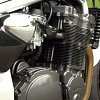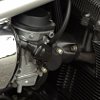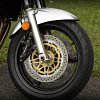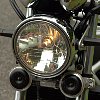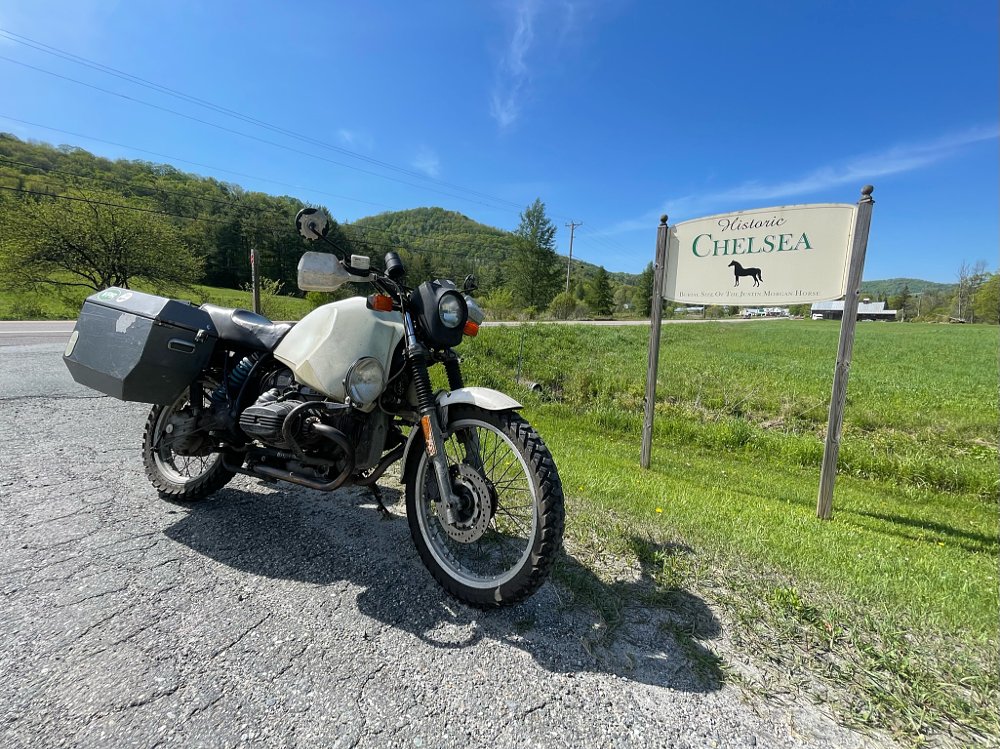Journalistic integrity would dictate I tell folks I'm reviewing a motorcycle with which I have a history. I don’t have a lick of that, so the editor of this lovely publication dictated it, instead. In what I think is a first for me, I am reviewing a bike I liked so much I bought it twice. I'll tell you why, and then I'll tell you what it's like to ride it.
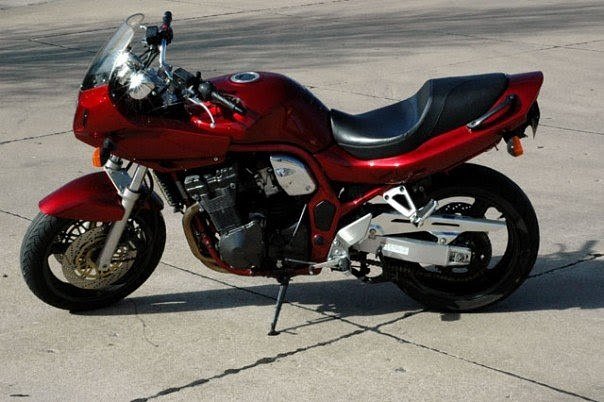
2003: First time around with the Bandit
In 2003, I went through a bad breakup that left me the owner of a 2003 Honda Shadow and a 2004 Honda Rebel. Young and hurt and financially clueless, I brought them to a motorcycle dealer that is now defunct and struck a trade deal. I swapped those two bikes for a 2000 Suzuki Bandit 1200 with 91 miles on it. ("The guy got scared of it and brought it back." Sure he did.) They wanted this deal consummated so badly they allowed a 19-year-old-kid wearing shorts, a T-shirt, helmet, and gloves a conditional test ride.
I kept that bike for several years. Later, I got in a tight spot for money and coughed up my pink slip to get by. It took me probably four or five years to find something I liked riding as much as I liked my Bandit, and even longer to realize how I happily spazzed into a bike that fit my riding style well.
Life kept going, and so did I.

2022: Second time around
I'm a sentimental fellow. I grow fond of tools that do their job. I think back wistfully on many bikes I've had. But I've never really chased a bike from my past. The fact I've not really landed a ton of doubles or triples is almost difficult to do when you buy and sell as often as I do. The best bike is almost always whatever one is underneath me at any given point. This year I've really been beating the bushes trying to find good stuff to fix up and sell. (It's been a lot of metric cruisers, which I don't mind at all, but the margins have been better for me on sportier stuff as of late.)
Recently, a familiar-looking machine popped up: a 2002 Suzuki Bandit 1200. I haven't seen one in a long time, and when I do run across 'em, they're pure whupped. They were cheap when they were new and got more affordable after they were crashed a few times, so every one I see is about two steps from falling apart. I got overexcited and bought it for entirely too much money at $5,300. Comps are all over the map, but even for a clean, original-paint bike, that price is close to the top.

In a move that's sort of rare for me, I left the trailer sittin' in the yard when I went to fetch this motorbike. Instead, I had Mrs. Lem drop me off so I could ride this bike home. I threw a leg over and realized I'd forgotten so much about the bike that it was a lot like riding it for the first time. Maybe I can review it fairly.
"Well," thought I, "It looks so tall! And so heavy!" I don't remember my old Bandito being that way, but I'm smaller and weaker these days, I guess, and I had less to compare it to back then. The seat height on most of these is right around 33 inches, and they weigh in at a claimed 485, but I'll eat my hat if a dressed, ready-to-roll Bandit weighs under five and a quarter, if not more. They're massive.

I suppose I ought to delve into a bit of the model history too, here. The 1200 Bandits (air- and oil-cooled and carbureted) are usually all lumped in together as "the same bike," but they do differ a bit from year to year. My 2000 was what is usually referred to as an "S" model, meaning it had a bikini fairing with an upside-down trapezoid headlight that looks awfully dated these days. This 2002, however, is an "N" machine, meaning it wears no bodywork and a big round headlight. In 2022, The N looks better, I feel, but that little half fairing did something, even for all its ugliness. I remember wind protection on my '01 being pretty good. In this generation, the bikes also came in a 600 form, too. That bike was lighter and a little less powerful. They were better all 'rounders, but less fondly remembered because of their better manners. (Those bikes had the same underpinnings as the rounded-body-style Katanas, another bike I owned and enjoyed immensely.)

I got the bike off its stand, thumbed the starter, and the engine dropped into the choppy idle I remembered better than I thought I would. Very soon after I rolled away, I began giving the bike some right wrist and it just sprang to life. I'm no wheelie king, but I can loft the front and fake my way into a one- or two-footer for the camera. It came rushing back to me that this was the bike I learned to do that on: first gear, 20 mph, tap the front lever, snap the throttle while covering the pedal. The engine is rowdy, and the air cooling and carbs means the damn thing bakes paint and oil and runs rich and smells like a motorcycle. Or at least it smells the way an over-the-hill rider remembers motorcycles smellin'.

I want to talk about that engine for a few paragraphs, because it's the whole point of this bike.
The motor is a legend. It was plucked from the Gixxer 1100 and "detuned." (That's what all the bike mags said back then.) In reality, the compression ratio was decreased and different cams were selected that brought the big top-end number down, but allowed the bike to make whoppin' torque in the basement and on the first floor. There was (and still is) a wealth of information on tuning this engine, a dragbike favorite. A good exhaust, carbs, and a Gixxer 750 exhaust cam is enough to bring them up to 140 horsepower — a significant increase over the 106 they packed as Suzuki issued them. More radical modification will yield more power, which the bottom end is plenty capable of taking. Not bad for an obsolete old dinosaur bike. If you're in the market for speed parts? 20 years ago, this guy was the king of hotrodding these things, and by all accounts, he still is.
So the engine is what makes this bike. Bikes such as the Kawasaki ZRX1200, the Triumph Speed Triple, and this Bandit, with an absurd amount of engine packed into a forgettable chassis, defined "muscle bike" perhaps a bit better than their cruiser counterparts claiming the same name. It's the same recipe the gow jobs and hot rods and Chouts and Tritons of years past cooked up. But though it's the centerpiece, there is more to the Bandit than just the engine.
Handling is a mixed bag — and it always was. I'm fat as a house now (285), and I was fat as a house back then (275), too. The Big Bandit wears a budget right-side-up fork. At 43 mm, it's not fitted with noodle tubes, but it ain't no upside-down 49 mm cartridge fork. The monoshock out back felt like it was sacked when it was brand new, and two decades of technology passing it by sure didn't help my opinion of it. The whole bike is a little squishy. Here's the best way I could relate it: A few years ago, my little brother gave me a 2013 Kawasaki Z1000 he stopped riding. If that bike was a scalpel, Bandito Grande is a very, very sharp sheath knife.

But it's still very good. And the reason it still seems good — and maybe even better — is threefold. The first is that my 2002 here is an N, and those were sprung more aggressively than the S models. So even though my weight went up, the springs stiffened a bit. The second is that I made a rudimentary sag adjustment, something 19-year-old-me never did. Get on and rip, right?
The final reason, I think, for what appears to be a bike that holds its own in the handling department is the tires. I can't remember what flavor of Bridgestone Battlaxs were on my 2000 Bandit (no doubt some obscure model-only Suzuki-spec bun made to a skinflint price point), but even as a big-bike rookie I could tell they sucked. My current Bandit's wearing a set of Dunlop Sportmax GPR300s, a tire I've been a big fan of since I first rode on 'em. So the bike didn't get better, the modern tires just made it less terrible.
Bringing this thing to a halt is uneventful. My 2000 had four-pot calipers up front, and in 2001, six pots became standard issue. The braking seemed about as I remembered it, but it's been 20 years. The brakes ain't winning any awards or breaking (braking?) any new ground, but they get the job done perfectly acceptably. The rear performs its function adequately. In fact, it may be the adequatest brake I've stepped on. Ultra-mediocre. There's no ABS, so… you know, don't screw up.

Final thoughts on the Suzuki Bandit 1200
I mean, in summary, this is a mundane chassis with a fireball of an engine packed into it. And lest we forget about the guiding characteristic of almost all used bike shoppers: it is astonishingly cheap. In a world where a new liter-displacement race rep is scratching at the door of 20 grand, a Bandit will still dust off most everything but serious race machines in all but the tightest twisties, and if you wanted to make a track animal out of one, it wouldn't take much beyond light tuning, tires, and suspension upgrades.
The bike is not as capable as a race-rep, but on the street you'd never know. It is also not nearly as uncomfortable as a race rep, with a very neutral position that makes stacking miles infinitely easier than its rearset relatives would have you believe is possible. It's fast and traditional and may be one of the least pretentious motorcycles I can think of.
Am I too easy on this heavy old relic? Maybe. But I really don't think so; I approach its flaws with clear eyes. In light of the price point, it's hard to find major fault with a motorcycle that's still serviceable and holding its own formidably 20 years after it rolled off the line, and 30 since the model was conceived — which might be why I'm still grinning aboard one years and years later.





